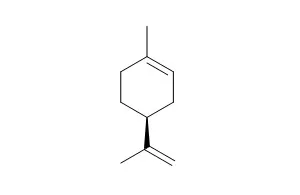| Structure Identification: |
| Phytochemistry, 2001, 57(2):199-208. | | Biotransformation of (R)-(+)- and (S)-(−)-limonene by fungi and the use of solid phase microextraction for screening.[Reference: WebLink] | The biotransformation of (R)-(+)- and (S)-(−)-limonene by fungi was investigated.
METHODS AND RESULTS:
More than 60 fungal cultures were screened for their ability to bioconvert the substrate, using solid phase microextraction as the monitoring technique. After screening, the best fungal strains were selected for further study and were grown as sporulated surface cultures in conical flasks and as submerged liquid cultures. It was found that (+)- and (−)-limonene were converted by Penicillium digitatum to α-terpineol (main metabolite), cis- and trans-p-menth-2-en-1-ol, neodihydrocarveol and limonene oxide (minor metabolites) using liquid cultures. The bioconversion of (R)-(+)- and (S)-(−)-limonene by Corynespora cassiicola yielded (1S,2S,4R)- and (1R,2R,4S)-limonene-1,2-diol respectively. The bioconversions by liquid cultures were also monitored by solid phase microextraction as a function of time. The optimum conversion of limonene to α-terpineol by Penicillium digitatum was obtained after 8 hours (yield up to 100%).
CONCLUSIONS:
Since an important pH-decrease was noticed in some liquid broths, the stability of limonene under acidic conditions was investigated. No acid catalysed conversion products were recovered after 8 days from control flasks at pH 3.5 containing limonene. |
|






 Cell. 2018 Jan 11;172(1-2):249-261.e12. doi: 10.1016/j.cell.2017.12.019.IF=36.216(2019)
Cell. 2018 Jan 11;172(1-2):249-261.e12. doi: 10.1016/j.cell.2017.12.019.IF=36.216(2019) Cell Metab. 2020 Mar 3;31(3):534-548.e5. doi: 10.1016/j.cmet.2020.01.002.IF=22.415(2019)
Cell Metab. 2020 Mar 3;31(3):534-548.e5. doi: 10.1016/j.cmet.2020.01.002.IF=22.415(2019) Mol Cell. 2017 Nov 16;68(4):673-685.e6. doi: 10.1016/j.molcel.2017.10.022.IF=14.548(2019)
Mol Cell. 2017 Nov 16;68(4):673-685.e6. doi: 10.1016/j.molcel.2017.10.022.IF=14.548(2019)